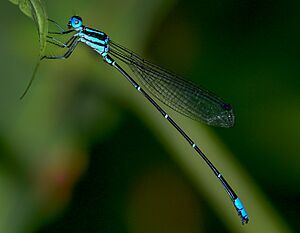Nilgiri bambootail facts for kids
Quick facts for kids Nilgiri bambootail |
|
|---|---|
 |
|
| Male | |
| Conservation status | |
| Scientific classification | |
| Genus: |
Esme
|
| Species: |
longistyla
|
The Esme longistyla is a type of damselfly. It belongs to the Platycnemididae family. People often call it the Nilgiri bambootail. This special insect lives only in the Western Ghats region of India. It's a unique part of nature there.
What Does It Look Like?
This damselfly is a medium-sized insect. Its body (abdomen) is about 42 to 44 millimeters long. Its back wings are about 28 to 29 millimeters long. It has striking blue eyes with black caps.
The top part of its body, called the thorax, is velvet-black. The sides of its thorax are a bright azure blue. You can see thin blue stripes on its back. There is also a wider black stripe on its side. The bottom part of its sides is a light blue color. The underside of the thorax can be greenish-yellow or blue.
Male Nilgiri bambootails have black legs. Their abdomen is long and thin. The first part of the abdomen is azure blue. The parts from segment 8 to 10 are also azure blue. The second segment is black. It has wide, uneven azure blue stripes on its sides. Segments 3 to 7 are black. They have azure blue rings at their ends. The sides of segment 10 and its tip are narrowly black. Its tail parts are black.
Female damselflies look much like the males. However, they are usually built a bit stronger.
The Nilgiri bambootail is smaller than its relatives. These include the Esme cyaneovittata and Esme mudiensis. These are the only other known Esme species in the Western Ghats. You can tell it apart by its tail shape. Also, the front part of its neck is all blue. Its back legs have blue markings.
Where Does It Live?
The Nilgiri bambootail likes to live near water. You can often find it resting on plants. These plants hang over fast-flowing forest streams. This damselfly also lays its eggs in these forest streams.
See also
- List of odonates of India
- List of odonata of Kerala


